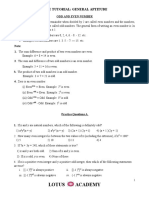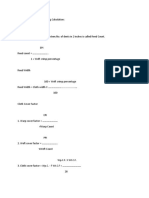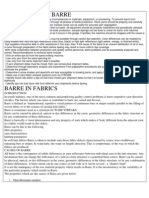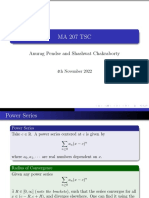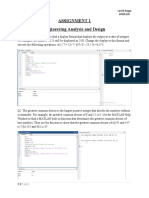0 ratings0% found this document useful (0 votes)
437 viewsCircular Convolution On Matlab
The document describes calculating the circular convolution of two functions using MATLAB. It provides the theory of circular convolution and describes a program that takes in two sequences, calculates their circular convolution using a for loop, and displays the output. The program output shows the circular convolution of the two example sequences [1 2 3 4 4 3 2 1] and [1 1 1 1].
Uploaded by
abhilash1889Copyright
© © All Rights Reserved
Available Formats
Download as DOCX, PDF, TXT or read online on Scribd
0 ratings0% found this document useful (0 votes)
437 viewsCircular Convolution On Matlab
The document describes calculating the circular convolution of two functions using MATLAB. It provides the theory of circular convolution and describes a program that takes in two sequences, calculates their circular convolution using a for loop, and displays the output. The program output shows the circular convolution of the two example sequences [1 2 3 4 4 3 2 1] and [1 1 1 1].
Uploaded by
abhilash1889Copyright
© © All Rights Reserved
Available Formats
Download as DOCX, PDF, TXT or read online on Scribd
You are on page 1/ 5
1
EXPERIMENT No. =06
OBJECT: - To calculate circular convolution of a function.
APPARATUS/SOFTWARE REQUIRED: - MATLAB 7.10.0(R2010a).
THEORY:-
The circular convolution, also known as cyclic convolution, of two a periodic function
(i.e. Schwartz functions) occurs when one of them is convolved in the normal way with
a periodic summation of the other function. That situation arises in the context of the Circular
convolution theorem. The identical operation can also be expressed in terms of the periodic
summations of both functions, if the infinite integration interval is reduced to just one period.
That situation arises in the context of the discrete-time Fourier transform (DTFT) and is also
called periodic convolution. In particular, the DTFT of the product of two discrete sequences is
the periodic convolution of the DTFTs of the individual sequences.
Let x be a function with a well-defined periodic summation, x
T
, where:
If h is any other function for which the convolution x
T
h exists, then the
convolution x
T
h is periodic and identical to:
where t
o
is an arbitrary parameter and h
T
is a periodic summation of h.
The second integral is called the periodic convolution of functions x
T
and h
T
and is
sometimes normalized by 1/T. When x
T
is expressed as the periodic summation of another
function, x, the same operation may also be referred to as a circular convolution of
functions h and x.
Similarly, for discrete sequences and period N, we can write the circular convolution of
functions h and x as:
2
PROGRAM: - The program is given below.
a=input('enter x(n):');
b=input('enter h(n):');
Nx=length(a);
Nh=length(b);
N=max(Nx,Nh);
x=[a zeros(1,(N-Nx))];
h=[b zeros(1,(N-Nh))];
for i=1:N
k=i
for j=1:Nh
H(i,j)=x(k)*b(j);
k=k-1
if (k==0);
k=N;
end
end
end
y=zeros (1,N);
M=H';
for j=1:N
for i=1:Nh
y(j)=M(i,j)+y(i);
end
end
disp('the output is');
disp(y);
stem(y);
title('circular convolution');
xlabel('n');
ylabel('y(n)');
PROGRAM OUTPUT:-
after execution
enter x(n):[1 2 3 4 4 3 2 1]
enter h(n):[1 1 1 1]
the output is 7 6 7 10 13 14 13 10
3
PROGRAM OUTPUT PLOT:-
Fig.: Output Plot of circular convolution
DOCUMENTATION OF PROGRAM:-
length
Length of vector or largest array dimension
Syntax
Number of Elements = length(array)
Description
Number of Elements = length(array) finds the number of elements along the largest dimension of
an array. array is an array of any MATLAB data type and any valid dimensions. Number Of
Elements is a whole number of the MATLAB double class.
For nonempty arrays, number Of Elements is equivalent to max(size(array)). For empty arrays,
number Of Elements is zero.
1 2 3 4 5 6 7 8
0
2
4
6
8
10
12
14
circular convolution
n
y
(
n
)
4
Max
Largest elements in array
Syntax
C = max(A)
C = max(A,B)
C = max(A,[],dim)
[C,I] = max(...)
Description
C = max(A) returns the largest elements along different dimensions of an array.
If A is a vector, max(A) returns the largest element in A.
If A is a matrix, max(A) treats the columns of A as vectors, returning a row vector containing the
maximum element from each column. If A is a multidimensional array, max(A) treats the values
along the first non-singleton dimension as vectors, returning the maximum value of each vector.
C = max(A,B) returns an array the same size as A and B with the largest elements taken from A
or B. The dimensions of A and B must match, or they may be scalar.
C = max(A,[],dim) returns the largest elements along the dimension of A specified by scalar dim.
For example, max(A,[],1) produces the maximum values along the first dimension (the rows) of
A.
[C,I] = max(...) finds the indices of the maximum values of A, and returns them in output vector
I. If there are several identical maximum values, the index of the first one found is returned.
5
for
Syntax
for variable = expression
statements
end
Description
The general format is for variable = expression
statement
...
statement
end
The columns of the expression are stored one at a time in the variable while the following
statements, up to the end, are executed. In practice, the expression is almost always of the form
scalar : scalar, in which case its columns are simply scalars. The scope of for statement is always
terminated with a matching end.
disp
Syntax
disp(X)
Description
disp(X) displays an array, without printing the array name. If X contains a text string, the string
is displayed. Another way to display an array on the screen is to type its name, but this prints a
leading "X =," which is not always desirable. Note that disp does not display empty arrays.
RESULT:- I have calculated the circular convolution of the function.
You might also like
- Comparison Between Rotor Spinning and Ring SpinningNo ratings yetComparison Between Rotor Spinning and Ring Spinning2 pages
- Knitting Technology II: Lecture Note 12, 13 &14 Etsehiwot Yisma 2019No ratings yetKnitting Technology II: Lecture Note 12, 13 &14 Etsehiwot Yisma 201916 pages
- Lotus Academy: Gate Tutorial: General AptitudeNo ratings yetLotus Academy: Gate Tutorial: General Aptitude32 pages
- Program 18: Largest of Two 8-Bit NumbersNo ratings yetProgram 18: Largest of Two 8-Bit Numbers3 pages
- Mathematics of Cryptography: Part III: Primes and Related Congruence EquationsNo ratings yetMathematics of Cryptography: Part III: Primes and Related Congruence Equations50 pages
- Major Formulas On Garments For BeginnersNo ratings yetMajor Formulas On Garments For Beginners27 pages
- Study On The Changes of GSM (Gmm2) of Grey Knitted Fabric From Pretreatment To FinishingNo ratings yetStudy On The Changes of GSM (Gmm2) of Grey Knitted Fabric From Pretreatment To Finishing18 pages
- Industrial Visit at Aboni Knitwear Ltd. (FINAL) TE5No ratings yetIndustrial Visit at Aboni Knitwear Ltd. (FINAL) TE515 pages
- 2nd Formative Assessment Question & Answer On Garments Quality Control ManagementNo ratings yet2nd Formative Assessment Question & Answer On Garments Quality Control Management3 pages
- Mass Customization (Research Article PPT) (Group-15)No ratings yetMass Customization (Research Article PPT) (Group-15)18 pages
- Functional Decomposition Top-Down DevelopmentNo ratings yetFunctional Decomposition Top-Down Development19 pages
- Presentation On Banswara Syntex Limited (BSL) : Submitted byNo ratings yetPresentation On Banswara Syntex Limited (BSL) : Submitted by8 pages
- Kinsella Bomber Shell Fabric Spec- POLY TWILL SW134744No ratings yetKinsella Bomber Shell Fabric Spec- POLY TWILL SW1347441 page
- Introduction of ER Model - GeeksforGeeksNo ratings yetIntroduction of ER Model - GeeksforGeeks2 pages
- Warping - Objects of Warping - Importance of Warping in Weaving - Textile LearneNo ratings yetWarping - Objects of Warping - Importance of Warping in Weaving - Textile Learne4 pages
- Textile Physics II (Tex 3027) Yarn CountNo ratings yetTextile Physics II (Tex 3027) Yarn Count12 pages
- Textile Quiz: Department of Textile Technology Vignan UniversityNo ratings yetTextile Quiz: Department of Textile Technology Vignan University60 pages
- Module 15 Knitting Calculations (Yarn Composition GSM and Width)No ratings yetModule 15 Knitting Calculations (Yarn Composition GSM and Width)16 pages
- Textile Worlds - Grey GSM Vs Finished GSMNo ratings yetTextile Worlds - Grey GSM Vs Finished GSM7 pages
- Practical No.1 Aim:-To Study Basic Concepts of MATLAB. TheoryNo ratings yetPractical No.1 Aim:-To Study Basic Concepts of MATLAB. Theory24 pages
- Correlatio and Convolution Using MatlabNo ratings yetCorrelatio and Convolution Using Matlab11 pages
- Department of Mathematics and Statistics: Section A100% (1)Department of Mathematics and Statistics: Section A7 pages
- By The Weierstrass M Test: First We ConsiderNo ratings yetBy The Weierstrass M Test: First We Consider8 pages
- 01 Functions, Function Notation, Domain & RangeNo ratings yet01 Functions, Function Notation, Domain & Range27 pages
- Assignment 1 Engineering Analysis and Design: Lavish Bagga 18105128No ratings yetAssignment 1 Engineering Analysis and Design: Lavish Bagga 181051288 pages
- 1-Module-1 Complex Variables-21-01-2023No ratings yet1-Module-1 Complex Variables-21-01-202320 pages
- 1.1: Functions: Reason: in Arrow Diagram (B), Domain A' Has Two100% (2)1.1: Functions: Reason: in Arrow Diagram (B), Domain A' Has Two12 pages
- Vdoc - Pub - Arithmetic of Quadratic FormsNo ratings yetVdoc - Pub - Arithmetic of Quadratic Forms81 pages
- LINEAR ALGEBRA AND VECTOR CALCULUS (GTU 2017) 4th Edition - eBook PDFpdf download100% (2)LINEAR ALGEBRA AND VECTOR CALCULUS (GTU 2017) 4th Edition - eBook PDFpdf download42 pages
- Comparison Between Rotor Spinning and Ring SpinningComparison Between Rotor Spinning and Ring Spinning
- Knitting Technology II: Lecture Note 12, 13 &14 Etsehiwot Yisma 2019Knitting Technology II: Lecture Note 12, 13 &14 Etsehiwot Yisma 2019
- Mathematics of Cryptography: Part III: Primes and Related Congruence EquationsMathematics of Cryptography: Part III: Primes and Related Congruence Equations
- Study On The Changes of GSM (Gmm2) of Grey Knitted Fabric From Pretreatment To FinishingStudy On The Changes of GSM (Gmm2) of Grey Knitted Fabric From Pretreatment To Finishing
- Industrial Visit at Aboni Knitwear Ltd. (FINAL) TE5Industrial Visit at Aboni Knitwear Ltd. (FINAL) TE5
- 2nd Formative Assessment Question & Answer On Garments Quality Control Management2nd Formative Assessment Question & Answer On Garments Quality Control Management
- Mass Customization (Research Article PPT) (Group-15)Mass Customization (Research Article PPT) (Group-15)
- Presentation On Banswara Syntex Limited (BSL) : Submitted byPresentation On Banswara Syntex Limited (BSL) : Submitted by
- Kinsella Bomber Shell Fabric Spec- POLY TWILL SW134744Kinsella Bomber Shell Fabric Spec- POLY TWILL SW134744
- Warping - Objects of Warping - Importance of Warping in Weaving - Textile LearneWarping - Objects of Warping - Importance of Warping in Weaving - Textile Learne
- Textile Quiz: Department of Textile Technology Vignan UniversityTextile Quiz: Department of Textile Technology Vignan University
- Module 15 Knitting Calculations (Yarn Composition GSM and Width)Module 15 Knitting Calculations (Yarn Composition GSM and Width)
- Practical No.1 Aim:-To Study Basic Concepts of MATLAB. TheoryPractical No.1 Aim:-To Study Basic Concepts of MATLAB. Theory
- Department of Mathematics and Statistics: Section ADepartment of Mathematics and Statistics: Section A
- Assignment 1 Engineering Analysis and Design: Lavish Bagga 18105128Assignment 1 Engineering Analysis and Design: Lavish Bagga 18105128
- 1.1: Functions: Reason: in Arrow Diagram (B), Domain A' Has Two1.1: Functions: Reason: in Arrow Diagram (B), Domain A' Has Two
- LINEAR ALGEBRA AND VECTOR CALCULUS (GTU 2017) 4th Edition - eBook PDFpdf downloadLINEAR ALGEBRA AND VECTOR CALCULUS (GTU 2017) 4th Edition - eBook PDFpdf download
















